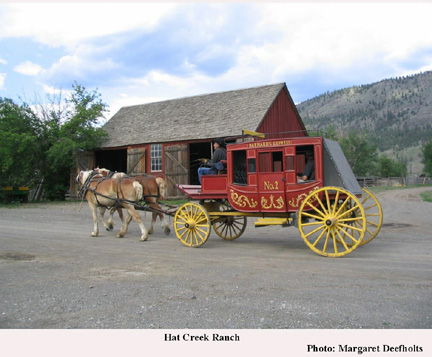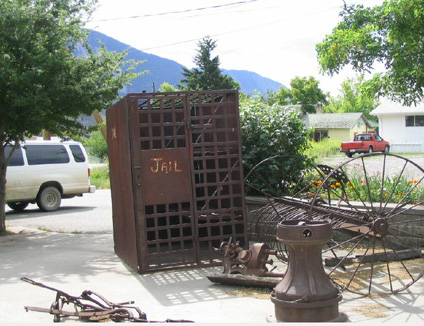Page 2
MURDER, MAYHEM AND MYSTERY ON THE CARIBOO
GOLD RUSH TRAIL
Our route winds through Lytton, and then up via Spencer's Bridge, Ashcroft, Cache Creek and Clinton . Lytton's main claim to fame is that it is the hottest spot in B.C., and today in early June, at 32 degrees centigrade, it lives up to its reputation. Beyond Lytton the earth turns ochre and the hills are pimpled with cactus. The landscape has a strange, eerie beauty: desolate and wild for a few miles and then, as we swing into the town of Ashcroft , the sagebrush gives way to homes and ranches. At the Ashcroft Museum , I find myself in a sepia world surrounded by images of the weather-beaten faces of pioneers, homesteaders, and transient miners; of mule train operators, and stage-coach drivers.
A few hours later at Hat Creek Ranch, I meet up again with Donald McLean whose packet of gold at the San Francisco mint set off the initial prospecting delirium. McLean , having retired from the Hudson Bay Company, decided to build this roadhouse as a staging halt along the Old Cariboo Road in 1861. Business was brisk through the next couple of decades as coaches and wagons halted to change horses, while miners and pioneers relaxed overnight, enjoying a hot meal and a bottle or two of whisky. Today the old coach road still exists as does McLean 's original log building, its walls adorned with photographs of the owner and his native Indian wife, its furnishings reminiscent of a long vanished era.

But not everything at Hat Creek Ranch has dissolved into the past. Some of its previous occupants are still in residence, and have been known to make their presence felt from time to time. The most frequent other-world visitor is a woman who knits away while sitting in a rocking chair in one of the bedrooms on the first floor of the house. Horrified onlookers report that she usually melts away within a few seconds, but an icy-cold draft along the passageway sends them rushing down the stairs in panic. Also frequently heard along the path running through the property, is the clatter of phantom hooves making their way to the barn, where the sound of a hammer wielded by an invisible blacksmith rings against an anvil. And most unnerving of all is the spectre of a man who sometimes materializes in the granary swinging from a noose tied to the rafters. To my disappointment none of these apparitions show up during our visit, so instead I content myself by clicking my camera at a very real horse and carriage as it makes its way along the old coach road.
No ghosts frequent the Clinton Museum , although Judge Begbie's chair reposing in one corner is a reminder of the years he spent on judicial circuits in the Cariboo. My attention, however, is caught another curious object—a battered metal safe, with its lid askew. It is only about a cubic foot in size, but it weighs a formidable 100 lbs. It had been found near 100 Mile Hill in 1914 by the Chief Constable at Clinton.
There is little doubt as to its history. Back in 1886, a desperado named Jack Rowlands had staged the first coach robbery in Cariboo history near 82 Mile House, holding the BX Express carriage up at gunpoint. How he managed to single-handedly lift the heavy safe containing $15,000 worth of gold dust as well as two gold bricks, and hoist this onto his horse, remains a mystery. Attempts at tracking the bandit down turned out to be futile, but a short while later Rowlands showed up at a bar in Ashcroft bragging that he'd struck it rich at Scotty Creek . Scotty Creek had been cleaned out several years previously, and a local policeman, Constable Burr, grew suspicious. He decided to examine the gold dust Rowlands had stashed in the F.W. Foster store safe, and straightened up with an “Aha” of satisfaction: the dust wasn't from Scotty's Creek; it was of a coarse variety, typical to the Barkerville area.

Rowlands was found guilty of armed robbery and sentenced to five years in jail, but escaped two years later and vanished across the US border. The gold bars were never found, but according to a letter addressed to F. Tingley (son of the legendary BX stage coach driver, Steve Tingley) on November 10th 1914, the safe found by the Chief Constable at Clinton, contained “a bundle of waybills, vouchers and reports along with a small leather treasure bag”[presumably empty]. The letter concludes “The safe was apparently opened with an axe, and I do not think it has any value.” Perhaps not in terms of utility, but as part of gold rush history the little strongbox holds within its buckled frame the tale of a highwayman brought to justice by a savvy police officer.